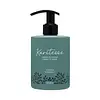What's inside
What's inside
 Key Ingredients
Key Ingredients

 Benefits
Benefits

 Concerns
Concerns

 Ingredients Side-by-side
Ingredients Side-by-side

Water
Skin ConditioningDecyl Oleate
EmollientGlycerin
HumectantEthylhexyl Palmitate
EmollientCetyl Alcohol
EmollientGlyceryl Stearate Citrate
EmollientButyrospermum Parkii Butter Extract
Skin ConditioningIsoamyl Laurate
EmollientOlus Oil
EmollientZea Mays Oil
EmulsifyingSodium PCA
HumectantTocopherol
AntioxidantRosa Moschata Seed Oil
EmollientTocopheryl Acetate
AntioxidantHelianthus Annuus Seed Oil
EmollientRosmarinus Officinalis Leaf Extract
AntimicrobialTapioca Starch
Parfum
MaskingGlyceryl Stearate
EmollientHydroxyacetophenone
AntioxidantCarbomer
Emulsion StabilisingXanthan Gum
EmulsifyingHydrogenated Palm Glycerides Citrate
EmollientPhenoxyethanol
PreservativeTetrasodium Glutamate Diacetate
Sodium Hydroxide
BufferingBenzyl Salicylate
PerfumingCoumarin
PerfumingCitronellol
PerfumingWater, Decyl Oleate, Glycerin, Ethylhexyl Palmitate, Cetyl Alcohol, Glyceryl Stearate Citrate, Butyrospermum Parkii Butter Extract, Isoamyl Laurate, Olus Oil, Zea Mays Oil, Sodium PCA, Tocopherol, Rosa Moschata Seed Oil, Tocopheryl Acetate, Helianthus Annuus Seed Oil, Rosmarinus Officinalis Leaf Extract, Tapioca Starch, Parfum, Glyceryl Stearate, Hydroxyacetophenone, Carbomer, Xanthan Gum, Hydrogenated Palm Glycerides Citrate, Phenoxyethanol, Tetrasodium Glutamate Diacetate, Sodium Hydroxide, Benzyl Salicylate, Coumarin, Citronellol
Theobroma Cacao Seed Butter
EmollientTheobroma Grandiflorum Seed Butter
Skin ConditioningButyrospermum Parkii Butter
Skin ConditioningPrunus Amygdalus Dulcis Oil
Skin ConditioningPEG-7 Glyceryl Cocoate
EmulsifyingGlyceryl Stearate Se
EmulsifyingArgania Spinosa Kernel Oil
EmollientSilica
AbrasiveMaranta Arundinacea Root Powder
Skin ConditioningBertholletia Excelsa Seed Oil
EmollientRosa Damascena Callus
AntimicrobialRosa Damascena Flower Oil
MaskingPelargonium Graveolens Oil
MaskingCitrus Limon Peel
MaskingLycium Barbarum Amino Acids
Skin ConditioningCyamopsis Tetragonoloba Gum
Emulsion StabilisingCitronellol
PerfumingCoumarin
PerfumingGeraniol
PerfumingLimonene
PerfumingParfum
MaskingTheobroma Cacao Seed Butter, Theobroma Grandiflorum Seed Butter, Butyrospermum Parkii Butter, Prunus Amygdalus Dulcis Oil, PEG-7 Glyceryl Cocoate, Glyceryl Stearate Se, Argania Spinosa Kernel Oil, Silica, Maranta Arundinacea Root Powder, Bertholletia Excelsa Seed Oil, Rosa Damascena Callus, Rosa Damascena Flower Oil, Pelargonium Graveolens Oil, Citrus Limon Peel, Lycium Barbarum Amino Acids, Cyamopsis Tetragonoloba Gum, Citronellol, Coumarin, Geraniol, Limonene, Parfum
Alternatives
Ingredients Explained
These ingredients are found in both products.
Ingredients higher up in an ingredient list are typically present in a larger amount.
Citronellol is used to add fragrance/parfum to a product. It is often derived from plants such as roses. In fact, it can be found in many essential oils including geranium, lavender, neroli, and more. The scent of Citronellol is often described as "fresh, grassy, and citrus-like".
Since the Citronellol molecule is already unstable, Citronellol becomes irritating on the skin when exposed to air.
Citronellol is a modified terpene. Terpenes are unsaturated hydrocarbons found in plants. They make up the primary part of essential oils.
Citronellol is not able to be absorbed into deeper layers of the skin. It has low permeability,
Citronellol is also a natural insect repellent.
Learn more about CitronellolCoumarins are a group of substances found naturally in plants. There are over 1300 types of coumarins identified. It has a natural vanilla scent.
Coumarin is an identified EU known allergy, meaning it may cause an allergic reaction when applied to the skin.
In many countries, coumarin is banned as a food additive. However, it can be found in soaps, tobacco products, and some alcohol drinks.
Plants use coumarins as a chemical defense. Some plants that have coumarins include lavender, tonka beans, and yellow clovers.
Learn more about CoumarinParfum is a catch-all term for an ingredient or more that is used to give a scent to products.
Also called "fragrance", this ingredient can be a blend of hundreds of chemicals or plant oils. This means every product with "fragrance" or "parfum" in the ingredients list is a different mixture.
For instance, Habanolide is a proprietary trade name for a specific aroma chemical. When used as a fragrance ingredient in cosmetics, most aroma chemicals fall under the broad labeling category of “FRAGRANCE” or “PARFUM” according to EU and US regulations.
The term 'parfum' or 'fragrance' is not regulated in many countries. In many cases, it is up to the brand to define this term.
For instance, many brands choose to label themselves as "fragrance-free" because they are not using synthetic fragrances. However, their products may still contain ingredients such as essential oils that are considered a fragrance by INCI standards.
One example is Calendula flower extract. Calendula is an essential oil that still imparts a scent or 'fragrance'.
Depending on the blend, the ingredients in the mixture can cause allergies and sensitivities on the skin. Some ingredients that are known EU allergens include linalool and citronellol.
Parfum can also be used to mask or cover an unpleasant scent.
The bottom line is: not all fragrances/parfum/ingredients are created equally. If you are worried about fragrances, we recommend taking a closer look at an ingredient. And of course, we always recommend speaking with a professional.
Learn more about Parfum